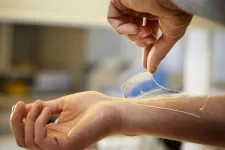(Press-News.org) Every high-school physics student learns that sound and light travel at very different speeds. If the brain did not account for this difference, it would be much harder for us to tell where sounds came from, and how they are related to what we see.
Instead, the brain allows us to make better sense of our world by playing tricks, so that a visual and a sound created at the same time are perceived as synchronous, even though they reach the brain and are processed by neural circuits at different speeds.
One of the brain's tricks is temporal recalibration: altering our sense of time to synchronize our joint perception of sound and vision. A new study finds that recalibration depends on brain signals constantly adapting to our environment to sample, order and associate competing sensory inputs together.
Scientists at The Neuro (Montreal Neurological Institute-Hospital) of McGill university recruited volunteers to view short flashes of light paired with sounds with a variety of delays and asked them to report whether they thought both happened at the same time. The participants performed this task inside a magnetoencephalography (MEG) machine, which recorded and imaged their brain waves with millisecond precision. The audio-visual pairs of stimuli changed each time, with sounds and visual objects presented closer or farther apart in time, and with random orders of presentation.
The researchers found that the volunteers' perception of simultaneity between the audio and visual stimuli in a pair was strongly affected by the perceived simultaneity of the stimulus pair before it. For example, if presented with a sound followed by a visual milliseconds apart and perceived as asynchronous, one is much more likely to report the next audio-visual stimulus pair as synchronous, even when it's not. This form of active temporal recalibration is one of the tools used by the brain to avoid a distorted or disconnected perception of reality, and help establish causal relations between the images and sounds we perceive, despite different physical velocities and neural processing speeds.
The MEG signals revealed that this brain feat was enabled by a unique interaction between fast and slow brain waves in auditory and visual brain regions. Slower brain rhythms pace the temporal fluctuations of excitability in brain circuits. The higher the excitability, the easier an external input is registered and processed by receiving neural networks.
Based on this, the researchers propose a new model for understanding recalibration, whereby faster oscillations riding on top of slower fluctuations create discrete and ordered time slots to register the order of sensory inputs. For example, when an audio signal reaches the first available time slot in the auditory cortex and so does a visual input, the pair is perceived as simultaneous. For this to happen, the brain needs to position the visual time slots a bit later than the auditory ones to account for the slower physiological transduction of visual signals. The researchers found that this relative delay between neural auditory and visual time slots is a dynamic process that constantly adapts to each participant's recent exposure to audiovisual perception.
Their data confirmed the new dynamic integration model by showing how these subtle tens-of-millisecond delays of fast brain oscillations can be measured in every individual and explain their respective judgments of perceived simultaneity.
In autism and speech disorders, the processing of the senses, especially hearing, is altered. In schizophrenia as well, patients can be affected by perceived distortions of sensory inputs. The neurophysiological mechanisms of temporal recalibration described in this study may be altered in these disorders, and their discovery may reveal new research goals to improve these deficits.
"Overall, this study emphasizes that our brains constantly absorb and adapt to the bombardment of sensory information from diverse sources," says Sylvain Baillet, a researcher at The Neuro and the study's senior author. "To make sense of our complex environments, including social interactions, brain circuits actively make adjustments of subtle physiological mechanisms to better anticipate and predict the nature and timing of external stimulations. That helps us build a resilient and adaptive mental map of their representation."
INFORMATION:
This study, published in the journal Communications Biology on May 11, 2021, was funded by a Canadian Institutes of Health Research (CIHR), a post-doctoral fellowship to first author Dr. Therese Lennert, and by grants to Dr. Sylvain Baillet from the National Institutes of Health (USA), the Natural Science and Engineering Research Council of Canada, the Canada Research Chair of Neural Dynamics of Brain Systems from CIHR , the Brain Canada Foundation with support from Health Canada, and the Innovative Ideas program from the Canada First Research Excellence Fund, awarded to McGill University for the Healthy Brains for Healthy Lives initiative.
The Neuro
The Neuro - The Montreal Neurological Institute-Hospital - is a world-leading destination for brain research and advanced patient care. Since its founding in 1934 by renowned neurosurgeon Dr. Wilder Penfield, The Neuro has grown to be the largest specialized neuroscience research and clinical center in Canada, and one of the largest in the world. The seamless integration of research, patient care, and training of the world's top minds make The Neuro uniquely positioned to have a significant impact on the understanding and treatment of nervous system disorders. In 2016, The Neuro became the first institute in the world to fully embrace the Open Science philosophy, creating the Tanenbaum Open Science Institute. The Montreal Neurological Institute is a McGill University research and teaching institute. The Montreal Neurological Hospital is part of the Neuroscience Mission of the McGill University Health Centre. For more information, please visit http://www.theneuro.ca
A novel technique for studying vortices in quantum fluids has been developed by Lancaster physicists.
Andrew Guthrie, Sergey Kafanov, Theo Noble, Yuri Pashkin, George Pickett and Viktor Tsepelin, in collaboration with scientists from Moscow State University, used tiny mechanical resonators to detect individual quantum vortices in superfluid helium.
Their work is published in the current volume of Nature Communications.
This research into quantum turbulence is simpler than turbulence in the real world, which is observed in everyday phenomena such as surf, fast flowing rivers, billowing storm clouds, or chimney smoke. Despite ...
Scientists at the Centro Nacional de Investigaciones Cardiovasculares Centro de Biología Molecular Severo Ochoa (CBM-CSIC-UAM) have discovered that the nitric oxide (NO) pathway is overactivated in the aortas of mice and patients with Marfan Syndrome and that the activity of this pathway causes the aortic aneurysms that characterize this disease.
The results of the study, published today in Nature Communications, reveal the essential role played by NO in Marfan Syndrome aortic disease and identify new therapeutic targets and markers of NO pathway activation that could be used to monitor disease status and progression.
Aortic aneurysm ...
A new paper in the Journal of the European Economic Association, published by Oxford University Press, indicates that distrust generated by a 2011 CIA-led vaccination campaign ruse designed to catch Osama Bin Laden resulted in a significant vaccination rate decline in Pakistan.
Using a local doctor, the US Central Intelligence Organization planned an immunization plan in Pakistan to obtain DNA samples of children living in a compound in Abbottabad where American authorities suspected Bin Laden was hiding in order to obtain proof of Bin Laden's location (because the presence of close ...
About 42% of rural school districts in the U.S. offered fully in-person instruction as of February, compared with only 17% for urban districts, according to a new RAND Corporation survey of school district leaders. The opposite pattern held for fully remote learning: 29% of urban districts offered fully remote instruction compared with 10% of rural districts and 18% of suburban districts.
The choice of in-person versus remote learning has important implications. Over a third of all U.S. school districts offering some form of remote instruction in early 2021 had shortened the school day, and a quarter had reduced instructional minutes.
"This survey shows how the choice of remote instruction has ramifications that extend beyond longstanding concerns about ...
Aqueducts are very impressive examples of the art of construction in the Roman Empire. Even today, they still provide us with new insights into aesthetic, practical, and technical aspects of construction and use. Scientists at Johannes Gutenberg University Mainz (JGU) investigated the longest aqueduct of the time, the 426-kilometer-long Aqueduct of Valens supplying Constantinople, and revealed new insights into how this structure was maintained back in time. It appears that the channels had been cleaned of carbonate deposits just a few decades before the ...
Researchers at Chalmers University of Technology, Sweden, have developed a new material that prevents infections in wounds - a specially designed hydrogel, that works against all types of bacteria, including antibiotic-resistant ones. The new material offers great hope for combating a growing global problem.
The World Health Organization describes antibiotic-resistant bacteria as one of the greatest threats to global health. To deal with the problem, there needs to be a shift in the way we use antibiotics, and new, sustainable medical technologies must be developed.
"After testing our new hydrogel on different types of bacteria, we observed a high level of effectiveness, including against those ...
In some countries of the WHO European Region, 1 in 3 children aged 6 to 9 years is living with overweight or obesity. Mediterranean countries have the highest rates of obesity, but the situation there is starting to improve.
These are some of the findings of a new WHO European Childhood Obesity Surveillance Initiative (COSI) report on the fourth round of data collection (2015-2017), presented at this week's European Congress on Obesity (held online this year). The report gives the latest data available on 6- to 9-year-olds in 36 countries in the region. A questionnaire collecting ...
New research presented at this year's European Congress on Obesity (held online, 10-13 May) shows that fat around the waist (abdominal obesity) is more important than general obesity as shown by body mass index (BMI) in predicting the severity of chest X-ray results in patients with COVID-19. The study is by Dr Alexis Elias Malavazos, I.R.C.C.S.Policlinico San Donato, San Donato Milanese, Italy, and colleagues.
Previous research has established that both chest x-ray (CXR) severity score and obesity are predictive risk factors for COVID-19 hospital admission. However, the relationship between abdominal obesity and CXR severity score is not fully explored. This retrospective cohort study analysed the association of different methods of measuring obesity, ...
New research presented at this year's European Congress on Obesity (held online, 10-13 May) reveals an association between increasing body mass index (BMI) and the risk of testing positive SARS-CoV-2, the virus which causes COVID-19. The study is by Dr Hadar Milloh-Raz, The Chaim Sheba Medical Center, Tel-HaShomer, Ramat-Gan, Israel, and colleagues.
Obesity-related factors, including changes to the innate and adaptive immune systems brought on by excess weight, are believed to be associated with an increased risk of contracting various viral diseases. ...
A new study published in The Lancet Infectious Diseases journal has found that the risk of delayed acute complications after non-hospitalised SARS-CoV-2 infection is low, but persistent symptoms in this group could lead to increased visits to general practitioners or outpatient clinics in the six months following infection. The study assessed only those complications that led to contact with hospitals.
Researchers assessed the risk of initiating medication and receiving a hospital diagnosis for a new condition by comparing individuals who tested positive via a PCR test for SARS-CoV-2 with individuals who had a negative test during the first wave of the pandemic in Denmark. Results found SARS-CoV-2 positive individuals ...



